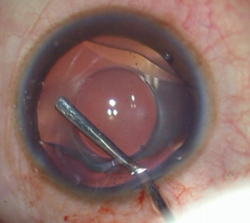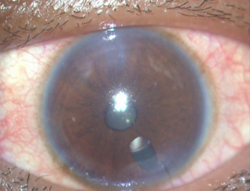Visco-cannula assists in reinversion of phakic lens
A simple technique repositions the IOL without explantation.
Phakic IOLs have been one of the promising ways in recent years to treat eyes with high myopia.
 Amar Agarwal |
Accidental upside down opening of the phakic Visian ICL (Implantable Collamer Lens, STAAR Surgical) in the anterior chamber is a rare complication of ICL implantation, and in this article, we will describe a new, simple technique of repositioning the inverted ICL on the table without explantation.
Upside down unfolding
In one case of an ICL implantation, a clear corneal incision of about 2.8 mm was made with a keratome in the superotemporal position. A viscoelastic substance was injected in the anterior chamber to maintain the space. The ICL was then loaded. The myopic version of the ICL that was used had an optic diameter that ranged from 4.65 mm to 5.5 mm. The overall diameter ranged from 11.5 mm to 12 mm. The ICL was injected through the clear corneal wound, and it was then noticed that the ICL had opened inverted (Figure 1).
In the older loading technique, the ICL is kept in the cartridge and pushed into the nozzle. This can lead to the lens coming out inverted, which is what happened in this case. To solve this problem, STAAR devised a new method of loading. In this new technique, instead of pushing, the ICL is pulled using special forceps passed through the nozzle of the cartridge. This prevents the ICL from coming out of the cartridge in the upside down position. Good preoperative mydriasis and controlled release of force while injecting are the other factors that aid in easy insertion.
Visco-cannula aided repositioning
The anterior chamber was formed with the viscoelastic Viscomet (2% hydroxypropyl methylcellulose, Sun Pharmaceutical Industries). The haptic edge of the ICL was tilted with the tip of the visco-cannula (Figure 2), and at the same time, the viscoelastic was injected behind the ICL. This step was repeated until the ICL was halfway folded. Then the visco-cannula tip was placed below the lower flap of the folded ICL, and the haptic edge was pushed up, thereby unfolding the ICL. This placed the ICL in the correct position (Figure 3). Care was taken not to touch the optical center of the ICL. Surgical peripheral iridectomy was performed, and the entry wound in the cornea was hydrated. The patient was put on topical antibiotics and steroids in the postoperative period (Figure 4).
 Figure 1. The ICL opened upside down. |
 Figure 2. The visco-cannula assisted reinversion of the ICL. The visco-cannula is placed below the haptic edge to elevate. Viscoelastic is then injected below the haptic: The haptic is rotated until it is halfway folded. Once the ICL is half-folded, the visco-cannula touches the haptic edge to rotate it. |
 Figure 3. The ICL is reinverted in the correct position. |
 Figure 4. Postop day 1 after reinversion of the ICL. Images: Agarwal A |
Results
We have repositioned the ICL in three eyes with this newer visco-cannula technique, and there have been no significant increases in the anterior chamber reaction in the immediate postoperative period. Endothelial counts and IOP have also been maintained at 6 months postop. There has been no loss in best corrected visual acuity, and no lens changes have been observed.
Discussion
In this technique of intraoperative reinversion of the ICL in the anterior chamber without explantation, the need for extended surgery or a second surgery is reduced. There is no need for wound extension, ICL explantation or reimplantation. This reduces surgical time, surgical trauma and postoperative suture-induced astigmatism.
There are several advantages of the visco-cannula — it is easily available, it induces less damage to the optic, and simultaneous viscoelastic injection prevents endothelial and lens damage while manipulating the ICL. Individual properties of a viscoelastic substance depend on its chemical and rheologic characteristics, and it is known that viscoelastics help in maintaining the chamber. There have been reports analyzing postoperative cataract after ICL implantation and surgical trauma-induced cataract during implantation.
In our cases, there was no endothelial damage or lens change, even at 6 months follow-up. We believe this method of reinversion can be comfortably done in phakic eyes with a minimum anterior chamber depth of 2.8 mm. This technique can be an easy way of positioning the ICL without explantation and a second surgery.
References:
- Agarwal A. Handbook of Ophthalmology. Thorofare, NJ: SLACK Incorporated; 2005.
- Agarwal A. Refractive Surgery Nightmares: Conquering Refractive Surgery Catastrophes. Thorofare, NJ: SLACK Incorporated; 2007.
- Agarwal S, Agarwal A, Agarwal A. Four volume textbook of ophthalmology. India: Jaypee; 2000.
- Amar Agarwal, MS, FRCS, FRCOphth, is director of Dr. Agarwal’s Group of Eye Hospitals. Prof. Agarwal is the author of several books published by SLACK Incorporated, publisher of Ocular Surgery News, including Phaco Nightmares: Conquering Cataract Catastrophes, Bimanual Phaco: Mastering the Phakonit/MICS Technique, Dry Eye: A Practical Guide to Ocular Surface Disorders and Stem Cell Surgery and Presbyopia: A Surgical Textbook. He can be reached at 19 Cathedral Road, Chennai 600 086, India; fax: 91-44-28115871; e-mail: dragarwal@vsnl.com; Web site: www.dragarwal.com.

